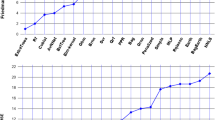Abstract
Forecasts of temperature in a “smart” building, i.e. one that is outfitted with sensors, are computed from data gathered by these sensors. Model predictive controllers can use accurate temperature forecasts to save energy by optimally using heating, ventilation and air conditioners while achieving comfort. We report on experiments from such a house. We select different sets of sensors, build a temperature model from each set, and compare the accuracy of these models. While a primary goal of this research area is to reduce energy consumption, in this paper, besides the cost of energy, we consider the cost of data collection and management. Our approach informs the selection of an optimal set of sensors for any model predictive controller to reduce overall costs, using any forecasting methodology. We use lasso regression with lagged observations, which compares favourably to previous methods using the same data.
Similar content being viewed by others
References
Álvarez J, Redondo J, Camponogara E, Normey-Rico J, Berenguel M, Ortigosa P (2013) Optimizing building comfort temperature regulation via model predictive control. Energ Buildings 57:361–372
Bjørn-Helge MRW (2007) The pls package: principal component and partial least squares regression in R. J Stat Softw 18(2):1–24. https://doi.org/10.18637/jss.v018.i02
EIA (2017) Frequently asked questions how much energy is consumed in u.s. residential and commercial buildings? https://www.eia.gov/tools/faqs/faq.php?id=86&t=1
Friedman J, Hastie T, Tibshirani R (2010) Regularization paths for generalized linear models via coordinate descent. J Stat Softw 33(1):1–22. http://www.jstatsoft.org/v33/i01/
Friedman J, Hastie T, Simon N, Tibshirani R (2016) Package glmnet: lasso and elastic-net regularized generalized linear models ver 2.0-. https://cran.r-project.org/web/packages/glmnet/glmnet.pdf
Mevik BH, Wehrens R, Liland KH (2015) pls: Partial least squares and principal component regression. https://CRAN.R-project.org/package=pls, r package version 2.5-0
Moreno MV, Zamora MA, Skarmeta AF (2014) User-centric smart buildings for energy sustainable smart cities. Transactions on emerging telecommunications technologies 25(1):41–55. https://doi.org/10.1002/ett.2771
Morosan P, Bourdais R, Dumur D, Buisson J (2010) Building temperature regulation using a distributed model predictive control. Energ Buildings 42(9):1445–1452
Pan D, Yuan Y D W, Xu X, Peng Y, Peng X, Wan P J (2012) Thermal inertia: towards an energy conservation room management system. In: Greenberg A, Sohraby K (eds) INFOCOM. IEEE, pp 2606–2610
Pérez-Lombard L, Ortiz J, Pout C (2008) A review on buildings energy consumption information. Energ Buildings 40:394–398
Prívara S, Široký J, Ferkl L, Cigler J (2011) Model predictive control of a building heating system: The first experience. Energ Buildings 43(2):564–572. https://doi.org/10.1016/j.enbuild.2010.10.022 . http://www.sciencedirect.com/science/article/pii/S0378778810003749
Romanski P, Kotthoff L (2016) Package ‘FSelector’ selecting attributes. R package version 0:21. https://cran.r-project.org/web/packages/FSelector/FSelector.pdf
Simon N, Friedman J, Hastie T, Tibshirani R (2011) Regularization paths for cox’s proportional hazards model via coordinate descent. J Stat Softw 39(5):1–13. http://www.jstatsoft.org/v39/i05/
Spencer B, Al-Obeidat F (2016) Temperature forecasts with stable accuracy in a smart home. In: SEIT Sustainable Energy Information Technology Conference. https://doi.org/10.1016/j.procs.2016.04.160
Spencer B, Al-Obeidat F, Alfandi O (2016) Short term forecasts of internal temperature with stable accuracy in smart homes. Int J Thermal Environ Eng 13(2):81–89
Spencer B, Al-Obeidat F, Alfandi O (2017) Selecting sensors when forecasting temperature in smart buildings, vol 109, pp 777–784. https://doi.org/10.1016/j.procs.2017.05.321. http://www.sciencedirect.com/science/article/pii/S1877050917309857, 8th International Conference on Ambient Systems, Networks and Technologies, ANT-2017 and the 7th International Conference on Sustainable Energy Information Technology, SEIT 2017, 16-19 May 2017, Madeira, Portugal
Tibshirani R (1996) Regression shrinkage and selection via the lasso: a retrospective. J R Stat Soc Ser B (Stat Methodol) 58(1):267–288. http://www.jstor.org/stable/2346178
UCI (2010) Sml2010 data set. https://archive.ics.uci.edu/ml/datasets/SML2010
United States Department of Energy (2012) Solar decathlon Europe competition. http://www.solardecathlon.gov
Yuan Y, Pan D, Wang D, Xu X, Peng Y, Peng X, Wan PJ (2013) A study towards applying thermal inertia for energy conservation in rooms. ACM Trans Sen Netw 10(1):7:1–7:25. https://doi.org/10.1145/2529050 . http://doi.acm.org.proxy.hil.unb.ca/10.1145/2529050
Zamora-Martínez F, Romeu P, Botella-Rocamora P, Pardo J (2013) Towards energy efficiency: forecasting indoor temperature via multivariate analysis. Energies 6(9):4639. https://doi.org/10.3390/en6094639. http://www.mdpi.com/1996-1073/6/9/4639
Zamora-Martínez F, Romeu P, Botella-Rocamora P, Pardo J (2014) On-line learning of indoor temperature forecasting models towards energy efficiency. Energ Buildings 83:162–172
Author information
Authors and Affiliations
Corresponding author
Ethics declarations
Funding information
The authors gratefully acknowledge the financial support of their organizations, and Zayed University’s RIF 17062 fund.
Rights and permissions
About this article
Cite this article
Spencer, B., Al-Obeidat, F. & Alfandi, O. Accurately forecasting temperatures in smart buildings using fewer sensors. Pers Ubiquit Comput 23, 921–929 (2019). https://doi.org/10.1007/s00779-017-1103-4
Received:
Accepted:
Published:
Issue Date:
DOI: https://doi.org/10.1007/s00779-017-1103-4




